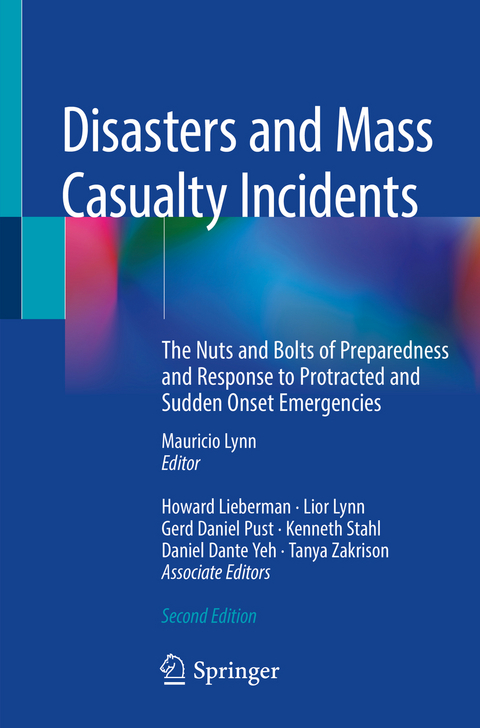
Disasters and Mass Casualty Incidents
Springer International Publishing (Verlag)
978-3-319-97360-9 (ISBN)
On the other hand, in a sudden disaster, there is an abrupt surge of victims resulting from an event such as anexplosion or a chemical release. After the sarin gas attack in a Tokyo subway in 1995, a total of 5500 victims were injured and required medical attention at local hospitals immediately after the attack. The car bomb that exploded near the American Embassy in Nairobi, Kenya, killed 213 people and simultaneously produced 4044 injured patients, many requiring medical care at local hospitals. The Madrid train bombing in March 2004 produced more than 2000 injured victims in minutes, overwhelming the city's healthcare facilities. More than 500 injured patients were treated at local hospital after the mass shooting in Las Vegas. Finally, earthquakes may produce a large number of victims in areas in which the medical facilities are partially or completely destroyed. Sudden events bring an immediate operational challenge to community healthcare systems, many of which are already operating at or above capacity.
The pre-hospital as well as hospital planning and responseto sudden mass casualty incidents (SMCI's) is extremely challenging and requires a standard and protocol driven approach. Many textbooks have been published on Disaster Medicine; although they may serve as an excellent reference, they do not provide a rapid, practical approach for management of SMCI's.
The first edition of "Mass Casualty Incidents: The Nuts and Bolts of Preparedness and Response for Acute Disasters" dealt exclusively with sudden mass casualty incidents. The second edition will expand its focus and include planning and response for insidious and protracted disasters as well.
This new book is designed to provide a practical and operational approach to planning, response and medical management of sudden as well as slow progressive events. The target audience of the second edition will be health care professionals and institutions, as well as allied organizations, which respond to disasters and mass casualty incidents.
Parts I and II are essentially the first edition of the book and consist of planning of personnel, logistic support, transport of patients and equipment and response algorithms. These 2 parts will be revised and updated and include lessons learned from major mass shootings that occurred recently in the United States and other parts of the world
Part III will describe the planning process for progressive disasters and include response algorithms and checklists.
Part IV will handle humanitarian and mental health problems commonly encountered in disaster areas.
Part V will deal with team work and communication both critical topics when handling catastrophes and mass casualty incidents.
This new book will be a comprehensive tool for healthcare professionals and managers and should
Mauricio LynnUniversity of Miami Miller School of MedicineJackson Memorial HospitalMiami, FLUSA Howard LiebermanUniversity of Miami Miller School of MedicineJackson Memorial HospitalMiami, FLUSA Lior LynnLynn Therapy, LLCPembroke Pines, FL USA Gerd Daniel PustUniversity of Miami Miller School of MedicineJackson Memorial HospitalMiami, FLUSA Kenneth StahlUniversity of Miami Miller School of MedicineJackson Memorial HospitalMiami, FLUSA D. Dante YehUniversity of Miami Miller School of MedicineJackson Memorial HospitalMiami, FLUSA Tanya L. ZakrisonUniversity of Miami Miller School of MedicineJackson Memorial HospitalMiami, FLUSA
General Information.- Pre-hospital Planning and Response to Sudden Mass Casualty Incidents.- Hospital Planning and Response to Sudden Mass Casualty Incidents.- Medical Challenges in Managing Blast Injuries.- Medical Aspects of Volcanic Eruptions.- Burns Mass Casualty Incident.- Medical Response to Mass Shootings.- Use of Tourniquets in Mass Casualty Incidents and "Stop the Bleed" Program.- Psychological Considerations in the Aftermath of School Sudden Mass Casualty Incidents.- Planning the Medical Response to Earthquakes.- Search and Rescue Techniques in the Aftermath of Earthquakes.- Management of Crush Injuries and Crush Syndrome.- Decontamination for Chemical Exposure: at the scene or at the hospital?.- Hospital Planning and Response for Sudden Chemical Mass Casualty Incidents.- Medical Principles for the Management of a "Dirty Bomb".- Maritime Sudden Mass Casualty Incidents.- Telemedicine to Manage Sudden Mass Casualty Incidents Remotely.- Challenges with Deceased and Body Parts Identification.- Planning Exercises and Drills for Sudden Mass Casualty Incidents.- Deployment of Field Hospitals to Sudden Onset Disasters.- Hospital Security Considerations during Sudden Mass Casualty Incidents.- Ethical Considerations in Sudden Mass Casualty Incidents and Disasters.- Mass Fatality Management in Mass Casualty Incidents.- Medical Planning and Response to Hurricanes.- Planning and Response for Biological Epidemics and Bioterrorism.- Management of Late Effects of Radiological Incidents.- Chronic Illnesses and Nutritional Support in the Aftermath of Disasters.- Humanitarian Aid in Sudden Onset and Progressive Disasters.- Mental Health Support during and in the Aftermath of Disasters.- Teamwork during Mass Casualty Incidents and Disasters.
"This book provides a very simplified description of the issues surrounding a mass casualty situation. It does not provide recommendations which are not already covered in other emergency medical service, emergency medicine, trauma surgery, or toxicologic references." (Daniel Joseph McCabe, Doody's Book Reviews, March, 2018)
“This book provides a very simplified description of the issues surrounding a mass casualty situation. It does not provide recommendations which are not already covered in other emergency medical service, emergency medicine, trauma surgery, or toxicologic references.” (Daniel Joseph McCabe, Doody's Book Reviews, March, 2018)
| Erscheinungsdatum | 27.11.2018 |
|---|---|
| Zusatzinfo | XII, 171 p. 81 illus., 75 illus. in color. |
| Verlagsort | Cham |
| Sprache | englisch |
| Maße | 155 x 235 mm |
| Gewicht | 290 g |
| Themenwelt | Medizin / Pharmazie ► Medizinische Fachgebiete ► Chirurgie |
| Schlagworte | Blast Injuries • Body identification • Decontamination • Dirty Bomb • first responders • MCI • Surge capacity |
| ISBN-10 | 3-319-97360-6 / 3319973606 |
| ISBN-13 | 978-3-319-97360-9 / 9783319973609 |
| Zustand | Neuware |
| Haben Sie eine Frage zum Produkt? |
aus dem Bereich


